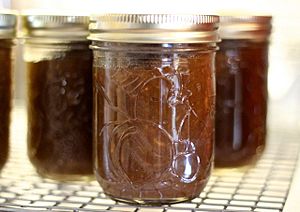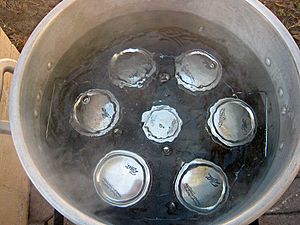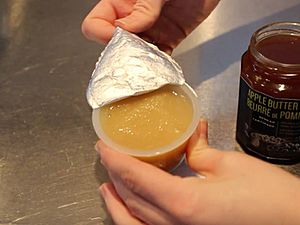Apple butter facts for kids
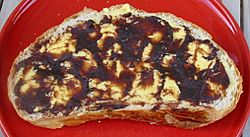
Apple butter on a slice of buttered bread
|
|
| Type | Spread |
|---|---|
| Place of origin | Belgium and the Netherlands |
| Main ingredients | Apples, cider or water |
Apple butter is a thick, sweet spread made from cooked apples. It's like a very concentrated apple sauce. To make it, apples are cooked slowly for a long time with cider or water. This process makes the sugar in the apples turn brown, giving apple butter its deep color. Because it has so much sugar, apple butter lasts a lot longer than regular apple sauce. It's a great way to save apples for later!
Contents
What is Apple Butter?
Apple butter doesn't actually have any dairy butter in it. The word "butter" just describes its thick, smooth texture, like soft butter. It's perfect for spreading on bread. Sometimes, people add spices like cinnamon or clove to make it taste even better. You can spread it on toast, use it as a side dish, or even bake with it. It can also add a fun flavor to sandwiches.
A Bit of History
Apple butter started a long time ago in the Middle Ages in places like Belgium, the Netherlands, and Germany. Monasteries, which were like big churches where monks lived, often had huge apple orchards. Making apple butter was a smart way to use and store all their extra apples. Back then, almost every village had people who made their own apple butter. It was also very popular in early America up until the 1800s.
Apple Butter Around the World
In Europe, some apple butters are more like thick syrups. In the Netherlands, it's called appelstroop (apple syrup), and in Germany, it's Apfelkraut. People often eat it on bread, sometimes with cheese. In Belgium, there's a sweeter version called sirop de Liège that uses pears too.
In Russia, a similar fruit spread is called povidlo. It's made by cooking fruit puree with sugar and spices. The most common povidlo is made from apples, but you can also find it made from apricots, cherries, or plums.
On the island of Jersey in the Channel Islands, apple butter is known as black butter. It even has liquorice in it! In Northern Ireland, it's called "Irish Black Butter."
In Japan, apple butter is often lighter in color and sometimes contains real butter. It's used on toast or as a filling for baked buns, similar to the red bean paste in anpan.
How Apple Butter is Used
Apple butter is super versatile! You can use it as a condiment or spread for pastries. It can even be a healthier substitute for oil or butter in recipes, especially in vegan cooking. Some people use it to marinate meat or pair it with cooked meats and cheeses like cheddar.
Making Apple Butter
Making apple butter takes time and care, but it's worth it!
Ingredients for Apple Butter
Here's what you usually need:
- Apples (peeled, cored, and chopped)
- Brown or white sugar (or natural sugar beet juice)
- Apple juice or apple cider
- Spices (like nutmeg, cloves, allspice, cardamom, vanilla extract, and lemon juice – these are optional)
Choosing the Right Apples
Different kinds of apples can be used. People pick apples based on how soft, sweet, or tart they are. Soft apples are often chosen because they break down easily and cook faster. Good choices include McIntosh, Cortland, or Granny Smith apples.
How It's Made
First, the best apples are chosen. Some are pressed to make fresh apple cider. The rest are peeled, cored, and then cooked until they become a smooth apple puree. The fresh cider and apple puree are mixed together in a large cooking pot. A tiny bit of baking soda might be added to make it less tart and bring out the natural sweetness.
Then, the mixture is boiled for a long time. This makes the water evaporate, and the mixture gets much thicker, sometimes reducing to just one-seventh of its original volume! The final thick, concentrated mixture is your delicious apple butter.
Storing Apple Butter
Apple butter is usually stored in jars or cans, whether it's made at home or in a factory.
Keeping It Fresh
Apple butter is made to last a long time. Because it's high in acid and sugar, and has very little "free water" (water that bacteria can use), an opened jar can stay good for months at room temperature. But there are ways to store it even better!
- Sterilizing Jars: Before filling, jars are often heated to kill any harmful germs. This helps keep the apple butter fresh and safe.
- Freezing: You can freeze apple butter to keep it good for a very long time. Freezing helps stop germs from growing, but it doesn't kill them if they were already there.
- Boiling Jars:
Boiling filled jars of apple butter helps remove oxygen and creates a tight seal. The heat also kills germs. This method works well for high-acid foods like apple butter.
- Vacuum Sealing: Similar to boiling, vacuum sealing removes oxygen from the jar, creating a tight seal that helps preserve the apple butter.
Why Apple Butter Lasts Long
Apple butter stays good for a long time because of a few things:
- Heat Treatment: Cooking the apples and then heating the jars kills most germs that cause spoilage.
- Low Water Activity: Adding sugar helps "bind" the water in the apple butter. This means there's less "free water" for germs to use and grow in.
- Acidity: Apples are naturally acidic (they have a low pH). This acidic environment makes it hard for most harmful germs to survive and grow. Sometimes, a little vinegar is added to make it even more acidic.
If apple butter isn't stored properly, it can spoil. You might see mold on the surface or notice a strange smell. If that happens, it's best to throw it away.
Apple Butter and Your Health
The nutritional value of apple butter can change depending on the recipe. Some recipes are very simple, while others have more ingredients. The main things you'll see on a nutrition label are carbohydrates and sugar. A tablespoon usually has about 4-15 grams of carbohydrates and 4-10 grams of sugar. It's not a big source of iron, calcium, or most vitamins, but it does have a little bit of vitamin C.
In the Netherlands, appelstroop is known for being a good source of iron. This is partly because sugar beets are often added to it, which contain iron. While apple butter can be a tasty spread, it's usually seen as an "accessory food" for its flavor rather than a main source of nutrients.
Food Safety
Apple butter is generally safe to eat and has a low risk of causing food-borne illnesses. It's preserved using a method called canning, which involves heating the sealed jars to kill germs.
However, if apple butter is not canned correctly, especially when made at home, dangerous germs like Clostridium botulinum can survive and grow. This germ produces a powerful toxin that can make people very sick or even be deadly. That's why it's super important for anyone making apple butter to make sure the jars are sealed tightly and heated for the right amount of time. Once a jar is opened, it should be kept in the refrigerator to slow down any germ growth.
Apple Butter vs. Apple Sauce
Apple butter and apple sauce might seem similar, but they have some key differences!
- Coring: For apple sauce, apples are usually cored (the middle part is removed). For apple butter, the whole apple (after peeling) is often used, which gives it a stronger apple flavor.
- Cooking Time: Apple sauce is cooked just until the apples are soft enough to be pureed. Apple butter, on the other hand, is cooked much longer until the apples turn brown, break down completely, and become very thick.
- Color and Texture: Because of the long cooking time, apple butter is a dark, caramel-brown color and is very thick and spreadable. Apple sauce is usually a lighter golden color and has a more liquid consistency.
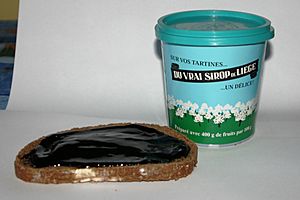

Apple Butter Events
In many places across the United States, making apple butter is a big community event, especially in the fall after the apple harvest. At these events, apple butter is often made the old-fashioned way: in huge copper kettles over open fires, stirred for hours by many people taking turns.
Some popular apple butter festivals include:
- Apple Butter Makin' Days in Mount Vernon, Missouri
- Annual apple butter festivals in Kimmswick, Missouri, and Berkeley Springs, West Virginia
- Apple Butter Fest in Grand Rapids, Ohio
- Apple Butter Stir Off in Belpre, Ohio
- Apple Butter and Cheese Festival in Wellesley, Ontario, Canada
- Apple Butter Festival at Fenner Nature Center in Lansing, Michigan
- Apple Butter Festival in Oak Glen, California, which marks the end of their apple harvest season.
These events are a fun way for communities to come together and celebrate this tasty tradition!
See also
In Spanish: Vin cuit (Suiza) para niños



